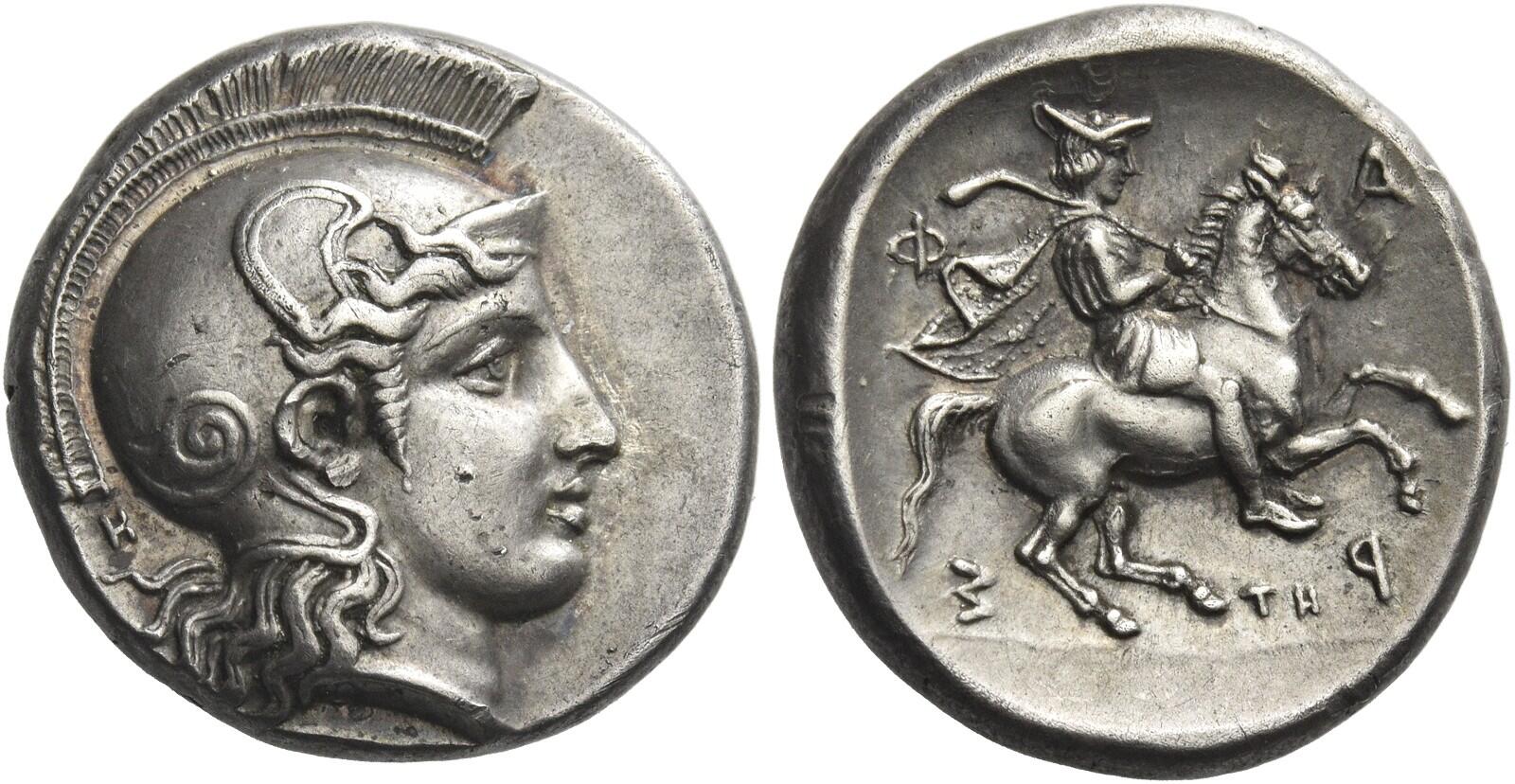Pharsalus, silver, drachms (425-350 BCE)
From SILVER
425 BCE - 350 BCE Silver 2,202 kg
Description
| ObverseInscription or printing placed on the obverse.: | Head of Athena r., wearing crested Attic helmet with raised cheek pieces, behind neck, ΤΗ and ΙΠ |
| ReverseInscription or printing placed on the reverse.: | ΦAPΣ (Greek).Thessalian horseman prancing r., with petasus, chlamys and chiton, and holding a lagobolon over his r. shoulder, below, ΤΗ |
Mint and issuing power
| MintIdentifies the place of manufacture or issue of a numismatic object.: | Pharsalus | Ancient regionAncient region.: | Thessaly | Modern countryModern country: Greece | AuthorityIdentifies the issuing power. The authority can be "pretended" when the name or the portrait of X is on the coin but he/she was not the issuing power. It can also be "uncertain" when there is no mention of X on the coin but he/she was the issuing power according to the historical sources: |
Chronology
| FromIdentifies the initial date in a range assigned in a numismatic context. | 425 BCE | toIdentifies the final date in a range assigned in a numismatic context.. | 350 BCE | PeriodTime period of the numismatic object.: Classical 480-323 BC |
Physical description
| MetalThe physical material (usually metal) from which an object is made.: | Silver |
Median weightMedian of the weights of numismatic objects (in grams). in grams | 5.90 | DenominationTerm indicating the value of a numismatic object. Examples: tetradrachm, chalkous, denarius.: | drachma |
StandardStandard.: |
Image

AC182 Pharsalus drachm.jpg [1]
References
| Die study referencePublication of the study: | Lavva 20011Lavva 2001, n° 78-109, 130-2, 137-8, 144-5, 152-9, 163 | ||
| Coin series referenceReference to coin series study: | Sear I2Sear I, n° 2190-2191, RQEMAC3RQEMAC, n° 182, HGC 44HGC 4, n° 624 | ||
| Coin series web referenceCoin series web references: | |||
Obverse dies distribution
| FrequencyFrequency of specimen in distribution. ᵖ | Number of obversesNumber of obverse dies. ᵖ (o) | % (o) | Number of coinsNumber of coins. (n) | % (n) | Die nameName(s) of the die(s). |
| 2 | 3 | 15.79 | 6 | 1.9 | 40, 44, 46 |
| 3 | 1 | 5.26 | 3 | 0.95 | 76 |
| 9 | 2 | 10.53 | 18 | 5.7 | 45, 51 |
| 13 | 1 | 5.26 | 13 | 4.11 | 48 |
| 14 | 1 | 5.26 | 14 | 4.43 | 43 |
| 16 | 2 | 10.53 | 32 | 10.13 | 47, 65 |
| 19 | 1 | 5.26 | 19 | 6.01 | 73 |
| 20 | 1 | 5.26 | 20 | 6.33 | 50 |
| 21 | 1 | 5.26 | 21 | 6.65 | 42 |
| 22 | 1 | 5.26 | 22 | 6.96 | 68 |
| 24 | 1 | 5.26 | 24 | 7.59 | 41 |
| 25 | 1 | 5.26 | 25 | 7.91 | 49 |
| 31 | 1 | 5.26 | 31 | 9.81 | 72 |
| 34 | 2 | 10.53 | 68 | 21.52 | 52, 61 |
| Total | 19 of 19 | 99.98 | 316 of 316 | 100 |
Reverse dies distribution
no distribution is available
Quantification
| Number of obversesNumber of obverse dies. ᵖ (o) | 19 | Number of singletons (o1)The number of singleton coins. ᵖ | |
| Number of reverse diesNumber of reverse dies. (r) | NC"NC" is not a number. | Number of coinsNumber of coins. (n) | 316 |
| Coins per obverse dieNumber of coins per obverse die. (n/o) | 16.63 | Coins per reverse dieNumber of coins per reverse die. (n/r) | |
| Reverse per obverse ratioRatio of obverse dies divided by reverse dies. (r/o) | Percentage of singletons (o1)number of coins (n) divided by the number of singletons (o1) ᵖ | % | |
| Original number of dies (O) (Carter 1983 formula)The estimation of the number of coins according to Carter 1983 ᵖ | 18.66 | Coins struck if 20,000 as average productivity per dieCoins made if the average productivity for obverses (according to Carter) is 20,000. ᵖ | 373,200 |
| Original number of dies (O) (Esty 2011 formula)The estimation of the number of coins according to the singleton formula in Esty 2011 ᵖ (O) | 20.22 | Survival rate if 20,000 as average productivity per dieSurvival rate if average productivity is 20,000. ᵖ | 0.00085 |
| Coverage (o = % of O) (Esty 1984 formula)Esty 1984 - coverage (% of O) ᵖ (o = % of O) | % | Die productivity if survival rate 1/2,000Average productivity if survival rate is 1/2,000. ᵖ | 33,869.24 |
| Weight of silver (in kg) if 20,000 coins per die (O = Carter formula)Carter 1983 * Median weight * 20000 (*10 if gold or electrum) ᵖ | 2,202 kg <br /> 2,202 kg | Die productivity if survival rate 1/5,000Average productivity if survival rate is 1/5,000. ᵖ | 84,673.1 |
Remarks